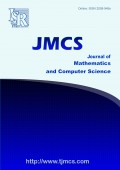Investigation of the Coal Diameter Effect on Pulverized Coal Combustion for Pollutant Reduction
-
2923
Downloads
-
5129
Views
Authors
M. R. Safaie
- Young Researchers and Elite Club, Mashhad Branch, Islamic Azad University, Mashhad, Iran.
B. Rahmanian
- Mashhad Branch, Islamic Azad University, Mashhad, Iran.
M. Goodarzi
- Mashhad Branch, Islamic Azad University, Mashhad, Iran
Abstract
The effect of increase diameter of coal particles on pulverized coal combustion to produce
pollutants such as \(NO_x, CO, CO_2\) and C in a 2D combustion chamber have been studied in this
research by finite volume method. The numerical method is a generalized finite rate formulation,
known as the Magnussen model, which is based on the solution of species transport equation for
reactants and product concentration. The diameter of the pulverized coal varied from 0.0001 m to
0.0004 m which enters by the rate of 0.1 kg/s from the center of furnace. Moreover, air was preheated
by a high-temperature gas generator, and the preheated oxidizer temperature could achieve \(1400^o\) C.
The results show that by increasing the diameter of pulverized coal, the rate of formation of pollutants
as well as \(NO_x\) and the temperature of the flame decreased.
Share and Cite
ISRP Style
M. R. Safaie, B. Rahmanian, M. Goodarzi, Investigation of the Coal Diameter Effect on Pulverized Coal Combustion for Pollutant Reduction , Journal of Mathematics and Computer Science, 12 (2014), no. 2, 143-151
AMA Style
Safaie M. R., Rahmanian B., Goodarzi M., Investigation of the Coal Diameter Effect on Pulverized Coal Combustion for Pollutant Reduction . J Math Comput SCI-JM. (2014); 12(2):143-151
Chicago/Turabian Style
Safaie, M. R., Rahmanian, B., Goodarzi, M.. "Investigation of the Coal Diameter Effect on Pulverized Coal Combustion for Pollutant Reduction ." Journal of Mathematics and Computer Science, 12, no. 2 (2014): 143-151
Keywords
- Pulverized Coal Combustion
- Pollutants Reduction
- Magnussen Model
- Turbulent Flow.
MSC
References
-
[1]
J. Kagawa , Health effects of diesel exhaust emissions—a mixture of air pollutants of worldwide concern, Toxicology, Vols. , 181–182 (2002), 349–353.
-
[2]
Japan Auto. Res. Ins., Report for automobile emission and chronic obstructive lung disease in small animals , (Ch. Res. Act. Comm.: J. Kagawa). Japan Auto. Res. Ins., Tsukuba, Japan (1994)
-
[3]
Japan Env. Agen, Dep. Env. Heal, A study report of the research method of health effects of local air pollution by animal exposure experiment , (Ch. Res. Act. Comm.: J. Kagawa), Japan Env. Agen., Japan (1999)
-
[4]
Q. Zhang, A. Swiderski, W. Yang, B. Wlodzimierz, Properties of pulverized coal combustion in high temperature air/steam mixture, Roy. Ins. of tech., (2006)
-
[5]
E. Therssen, L. Gourichon, L. Delfosse, Devolatilization of coal particles in a flat flame, Comb. Flame, 103 (1995), 115-128
-
[6]
Behnam Rahmanian, Mohammad Reza Safaei, Salim Newaz Kazi, Goodarz Ahmadi, Hakan Fehmi Oztop, Kambiz Vafai, Investigation of pollutant reduction by simulation of turbulent non-premixed pulverized coal combustion, App. Therm. Eng. , 1222-1235 (2014)
-
[7]
Norbert Peters, Turbulent Combustion, Cambridge University Press, (2000)
-
[8]
Thierry Poinsot, Denis Veynante, Theoretical and Numerical Combustion , R. T. Edwards, Inc., (2005)
-
[9]
M. Goodarzi, M. R. Safaei, K. Vafai, G. Ahmadi, M. Dahari, S. Kazi, N. Jomhari, Investigation of nanofluid mixed convection in a shallow cavity using a two-phase mixture model, Int. J. Therm. Sci., 75 (2014), 204-220.
-
[10]
M. Goodarzi, M. R. Safaei, Hakan F. Oztop, E. Sadeghinezhad, M. Dahari, S. N. Kazi, Numerical Study of Entropy Generation due to Coupled Laminar and Turbulent Mixed Convection and Thermal Radiation in an Enclosure Filled with a Semitransparent Medium, Sci. World J., vol. 2014, Article ID 761745, 8 pages, doi:10.1155/2014/761745. (2014)
-
[11]
S. V. Patankar, Numerical heat transfer and fluid flow, Washigton DC, Hemisphere publishing corporation (1980)
-
[12]
M. R. Safaei, B. Rahmanian, M. Goodarzi, Numerical study of laminar mixed convection heat transfer of power-law non-Newtonian fluids in square enclosures by finite volume method, Int. J. Phys. Sci., 6(33) (2011), 7456 – 7470.
-
[13]
M. R. Safaei, H. R. Goshayeshi, B. Saeedi Razavi, M. Goodarzi, Numerical investigation of laminar and turbulent mixed convection in a shallow water-filled enclosure by various turbulence methods, Sci. Res. Essays, 6(22) (2011), 4826-4838.
-
[14]
M. R. Safaei, M. Goodarzi, M. Mohammadi, Numerical modeling of turbulence mixed convection heat transfer in air filled enclosures by finite volume method, Int. J. Multiphysics, (2011)
-
[15]
A. Karimipour, M. Afrand, M. Akbari, M. R. Safaei, Simulation of Fluid Flow and Heat Transfer in the inclined enclosure, Int. J. Mech. Aerospace Eng., 6 (2012), 86-91
-
[16]
M. R. Safaei, B. Rahmanian, M. Goodarzi, Numerical Study of Laminar Mixed Convection Heat Transfer of Power-Law Non-Newtonian Fluids in Square Enclosures by Finite Volume Method, Int. J. Phys. Sci., 6(33) (2011), 7456 - 7470
-
[17]
B. Rahmanian, M. Ghazikhani, Effect of steam injection in pulverized coal combustion to reduce pollutants, 6th Int. Chem. Eng. Cong. (2009) Kish Island, Iran (2009)

